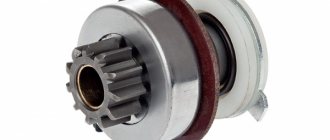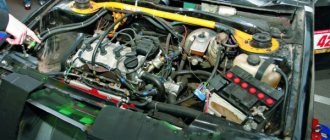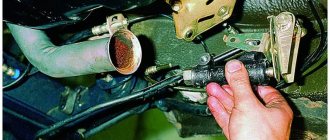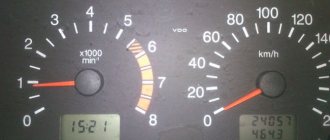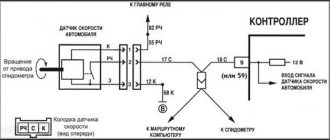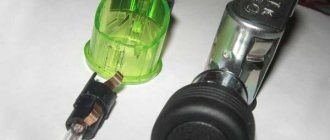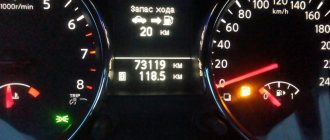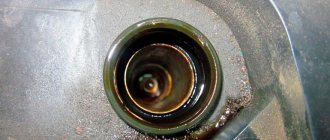If the power of the car’s engine drops, there is a malfunction in the engine’s operation, and to drive even up a not-so-steep hill you need to engage second gear, you can identify a misfire in the cylinder. In this case, the electronics display error P. We will explain in the article what causes misfire and how to detect it.
Misfires - what is it?
Let's start with what is a cylinder misfire? This phrase means a situation where in one of the cylinders the ignition of the fuel mixture occurs late or slow. Simply put, the “acceleration” of the piston in some of the cylinders is slower than in the others. As a result, there is a violation of the synchronization of the engine, the engine runs unevenly, jerking occurs, fuel consumption increases, and the dynamics of the car decreases so much that even a small hill becomes a big test. In addition, in cars equipped with an ECU, a corresponding error appears on the display in the form of a code, for example “P0304” - misfire in the fourth cylinder. The last digit in the code corresponds to a specific cylinder.
The best
In fact, Volodya seems to have said everything and already asked. The only thing is that since the vehicle says that replacing the spark plugs/wires helped for a while, it means that gasoline is most likely being supplied, but either not as needed, or the problem is already in the cylinder (valve/ring).
Watching the operation of the injector, measuring compression, and the appearance of the spark plugs has not yet been canceled as a diagnostic sign.
Oh, yes... and in the future, it is advisable not to reveal an inoperative cylinder by pulling off the explosive wires, because that’s exactly what I understood from the text.
Misfires - causes
First, you should perform a visual check of those parts that most often cause misfires in the cylinders. We are talking about spark plugs, explosive wires, and the ignition coil.
- High voltage wires (HV wires). These should be checked first. To begin with, as I said, it is necessary to carry out a visual inspection for the presence of breaks, cracks and other damage. After inspection, if everything is in order, it is recommended to ring the explosive wires and replace them if necessary.
- Spark plug. After the explosive wires, the spark plugs should be checked secondly, since quite often they are the cause of leaks. The spark plugs may have too much gap, they may be worn or punctured, causing the spark plug to flow intermittently or not at all.
- Ignition coil modules. If this part fails, misfires may occur in the cylinders.
Next about more global problems.
- TVS. The air-fuel mixture, or rather its quality, can often cause misfires in the cylinders. Due to low-quality fuel, contamination of injectors and fuel equipment occurs. Also, if the proportions are violated, for example, when the mixture is too rich or lean, components such as the fuel pump, fuel pressure regulator may fail, and the filter may very soon become clogged. Also, if the mixture is too “lean”, that is, it consists more of air (due to air leaks), ignition may occur intermittently, since a regular spark will simply not be enough to ignite this fuel assembly.
- Compression in cylinders. Poor and uneven compression can lead to insufficient compression of the fuel assembly, resulting in uneven and intermittent ignition.
- Timing belt malfunctions. In case of increased or excessive wear in the parts of the gas distribution mechanism or the presence of leaks in the hydraulic compensators, leaks may occur in the engine cylinders.
- Air leak. If an air leak occurs between the head and the intake manifold, it is quite possible that an error will appear indicating that misfire occurs in one of the cylinders.
Diagnostics should be comprehensive and continue until the engine runs smoothly without interruptions or misfires. As you can see, the topic is quite extensive and the reasons for misfires in the cylinders can be very different. If symptoms indicating omissions appear, it is recommended to carry out a visual inspection and, if any malfunction is detected, eliminate it. However, if the cause of the misfire has not been established independently, you should seek help from specialists who, using special equipment, will quickly and accurately determine what is wrong and why misfire occurs in the cylinder of your engine.
That’s all I have, thank you for your attention, I would be grateful if you complement me in the comments, and also if you share this article with your friends on social media. networks using the buttons below.
Theme Options
VAZ 2107 Misfires
And then the connection with the ECU was lost. Subsequently, all attempts to restore the connection were in vain. But the car, although poorly, works. The ECU on the seven is BOSCH 2104-1411020-10. Checked all connections, fuses, connectors. I don’t know after which of the procedures the connection was restored. Same mistakes. The car is shaking. We checked the ignition module - the primary and secondary windings are in order. The owner installed new spark plugs. The high-voltage wires are really old, but my partner doubts that they could be the reason.
Tell me which other corner to poke my nose into.
Answer: VAZ 2107 Misfire
Look at the compression injector ignition module or the keys in the block
Well, there are gaps for just a few reasons: 1. ignition problems - with contact ones “this is a feature, not a bug” (C), the most serious case is a different gap in the cylinder head for different cylinders. and most often - a broken bearing or poor contact 2. improper quality of the mixture - rich or lean 3. problems with phases - here you have a chain and gaps “in the valves” ..
I would put BSZ, and then I would look. I myself have matured into BSZ after struggling with CG EVERY week, then it will burn out (Pulsar will help) or the gap will go away - it cannot be treated. Sergey Sh.
Misfires
Misfires are a fairly common phenomenon characteristic of domestic car engines. This breakdown represents an imbalance in the operation of the cylinders, which manifests itself in the difference in the speed of their movement. One element moves more slowly than others, which can lead to reduced performance of the power unit. As a result of such a breakdown, exhaust emissions deteriorate and fuel consumption increases.
In the most difficult cases, there is a significant decrease in speed, and jerks may occur during movement, especially noticeable at the start and during acceleration. We will not list all the negative consequences that arise in a chain reaction with the appearance of each new sign of a malfunction. Every car owner understands perfectly well that a car is like a human body; if a problem arises, it must be solved immediately so as not to aggravate the situation through inaction. In this article we will look at misfires and the reasons for their occurrence. This information will help you understand the problem in detail and solve it without the help of specialists.
Distributor and capacitor
If the problem is in the capacitor on the distributor (and it can either fail completely or partially), then the engine will start and can operate properly and stably at idle speed. But while moving, the unit will twitch. This indicates a damaged capacitor. Remove the cover from the distributor, move the slider so that the contact opens. How is it checked? Turn the slider by hand to open the contact.
During the opening process, a spark should jump. If the capacitor is damaged, it will be blue and quite strong.
Also, the distributor may have insufficient or excessively large gap in the contacts. This causes unstable operation of the motor. The rod may wobble from side to side. It has cams and a slider installed. The contacts will open without much clarity, which will cause interruptions. The rod bushings or the entire distributor should be replaced.
Causes of misfire
Compression failure . When this defect occurs, the fuel mixture is not subjected to the necessary compression force. Checking the quality of this procedure is quite simple. In the event of a breakdown, gasoline is poured out of the cylinder back into the fuel system without ignition.
Spark plugs are the most common cause among drivers who do not carry out regular technical inspections. As a rule, the electrodes of the spark plugs are covered with soot, and after cleaning it, the problem is eliminated. In other cases, a misfire may be due to a failure of the spark plug itself or a change in the spark gap, more or less than the desired value.
Solution
To do this, you need to put a high-voltage conductor on the spark plug and crank the engine, while looking at the spark. If it is bright blue, then this is normal. A weak spark or its absence indicates that the spark plug needs to be replaced or the insulation checked. Place a new or proven spark plug on it and check the spark again. If there are no changes, then check the wire.
Take a multimeter and measure the resistance of the wire, which should be within 20 Kom. Owners of a VAZ 2110 whose engine is running cold, inspect the spark plug tips inside; there should be no traces of an electric arc breakdown, dots or discoloration of the tip. You can try replacing the wire with a new one or a working one.
Diagnosis of misfires on a VAZ (Video)
You can identify the cause of misfire on a modern car, where most components and mechanisms have been replaced with units with electronic control systems, in a few minutes using the appropriate built-in programs or special equipment. Of course, the exception is some stages that require visual inspection. For domestic transport, there is no such simple way to perform testing using modern electronic diagnostic tools. In this case, you need to resort to step-by-step verification of parts that affect the operation of the cylinders. The whole process can be divided into 6 operations:
1) Check the wiring . Poor condition of high-voltage cables is often the cause of misfire. Carefully check the insulation protection, the quality of the connectors and the reliability of their fixation. There should be no cracks or chips on the surface. Often the cause of loss of contact can be a bend in the core, this is especially true for old cables. To check, you can use a simple design with a light bulb and a battery. If there are problems with the wiring, you will quickly realize it. 2) Checking the spark plugs . Each element must be unscrewed and carefully inspected for proper clearance, damage or clogging. 3) We disassemble the ignition distributor . It is a rather complex element, for working with which it is best to use a diagram. This will eliminate the slightest errors during reassembly and will significantly speed up the work. 4) Checking compression in cylinders . To perform this procedure, you will need a pressure gauge and a special attachment for the spark plug connector. A nozzle is inserted into the hole and the pressure inside the system is checked using a pressure gauge.
5) Checking valves . First you should make sure of their quality, and then check the level of adjustment. Valves are often the cause of misfires. However, it is recommended to inspect them only after all the operations described above have been carried out. Valve settings can spontaneously get lost due to the car receiving serious mechanical shocks. The condition of the seal also plays an important role. When it wears out, compression decreases sharply. 6) Checking the cylinders . No tools are needed for this procedure. To check each cylinder step by step, you need to turn on the engine at idle. Then disconnect the wires from the spark plugs one by one. When the cable is disconnected, the operation of the motor should change and this way you can determine the faulty mechanism.
Warning . It is worth understanding that the above diagnostic method is quite dangerous, since it is necessary to work with hot parts and high voltage. You need to be extremely careful and perform all stages as carefully and carefully as possible. Otherwise there is a risk of injury. Because of this, this procedure can only be carried out by experienced drivers.
Checking the EPHH needle valve.
We also remove the hose from the side outlet (fitting “2”) of the electro-pneumatic valve and connect this hose to the economizer. We start the engine. If the economizer valve is working properly, the engine should run at low speed. If the engine stalls at idle, the valve diaphragm may rupture.
To change the valve, disconnect the wires from the microswitch terminals.
2. Using a screwdriver, unscrew the two screws securing the economizer housing to the carburetor.
3. Remove the bracket with the microswitch...
4. ...as well as the economizer assembly.
5. Remove the gasket from the economizer.
6. Unscrew the two bolts holding the body and economizer cover together...
7. We halve the economizer and check the condition of the diaphragm.
If the diaphragm is defective or the needle and seat are worn, we replace the economizer assembly.
On older models it was possible to change parts individually.
We install the new economizer in the reverse order.
5.1.3 Interruptions in engine operation
5.1.4. Interruptions in engine operation
| GENERAL INFORMATION |
What should you do if your car’s engine, which until recently worked “like a clock” in all modes, suddenly began to falter, jerk at idle, and stopped developing sufficient power? Interruptions, as a rule, are explained by incorrect carburetor adjustment, a faulty spark plug or one of the cylinders, or air leaks into one of the cylinders. It is necessary to find the fault and, if possible, eliminate it.
1.
Start the engine and let it idle. Go to the exhaust pipe and listen to the sound of the exhaust. The sound should be even, “soft”, of the same tone. Popping noises from the exhaust pipe at regular intervals indicate that one cylinder is not working due to a failed spark plug, lack of spark on it, a strong air leak into one cylinder or a significant decrease in compression in it. Popping noises occur at irregular intervals due to improper carburetor adjustment, ignition, severe wear or dirty spark plugs.
Popping sounds from the exhaust pipe at regular intervals?
4.
Check the condition of the ignition system wires. High-voltage wires must not have insulation damage, and their tips must not be oxidized.
Are the wires damaged?
7.
Remove the ends of the high-voltage wires and remove the spark plugs with a spark plug wrench.
Warning
When removing high-voltage wire lugs, never pull on the wire itself. Place your hand directly on the tip and twist it from side to side and then pull before removing it.
9.
If all the spark plugs look good, reinstall them and connect the high-voltage wires.
Warning
Do not fix the spark plug to the oil filler neck, oil dipstick, fuel pump, fuel hoses, or carburetor.
Reliable contact of the body or threaded part of the spark plug with the “ground” is optional, but desirable. Connect the high-voltage wire from cylinder 1 to the spare spark plug. Start the engine.
Has the engine trouble gotten worse?
11.
Replace the spark plug in the cylinder with a known good one. Attach the high voltage wire and start the engine.
Are engine interruptions still occurring?
If the diagnosis reveals a malfunction of the 3rd cylinder, remove the hose connecting the vacuum brake booster to the engine, turn it off securely and start the engine.
If engine interruptions stop, contact a car service center to diagnose and replace the vacuum brake booster.
Diagnostics of the engine condition by the appearance of the spark plugs
Symptoms.
Brown or grayish-yellowish color and slight wear on the electrodes. Accurate thermal value for engine and operating conditions.
Symptoms.
Dry soot deposits indicate a rich air/fuel mixture or late ignition. Causes misfire, difficult engine starting and unstable engine operation.
Symptoms.
Oily electrodes and spark plug insulator. The reason is oil getting into the combustion chamber. Oil enters the combustion chamber through valve guides or piston rings. Causes difficult starting, cylinder misfires and jerking of the running engine.
Symptoms.
Glossy white center electrode insulator, burnt electrodes and no deposits. Leads to a reduction in spark plug life.
Symptoms.
Melted electrodes. The insulator is white, but may be contaminated due to missed sparks and deposits from the combustion chamber falling on it. May cause engine damage.
Symptoms.
The insulator is yellowish, covered with glaze. Indicates that the temperature in the combustion chamber suddenly rises during sudden acceleration of the vehicle. Normal deposits become conductive. Causes misfires at high speeds.
Bridge between electrodes
Symptoms.
Deposits from the combustion chamber fall between the electrodes. “Heavy” deposits collect in the gap between the electrodes and form a bridge. The spark plug stops working and the cylinder stops working.
Timing marks
If the camshafts are incorrectly aligned relative to the crankshaft
– the reason for the engine tripping. The opening and closing timing of the intake and exhaust valves will not coincide with the engine strokes.
For example, at TDC of the piston the valve may be closed, so a flash will occur not only in the cylinder, but in the intake or exhaust manifold, depending on which valve is not closed.
This may occur due to a stretched timing drive.
. As the chain or belt is used, it stretches. Therefore, the opening or closing angles may shift. This leads to engine tripping.
What to do
If you have checked everything: the spark plugs are in order, there is a spark everywhere, the quality of the mixture is at the right level, you need to check the timing marks. We look at the degree of belt tension. In the case of a chain, how “out” the tensioner is. If the marks are knocked down, then we set them as needed.
After troubleshooting, we fix the problem. If the motor stops running, the cause has been found and eliminated.
VAZ 2107 misfires in cylinder 2
- Author
- Message
VAZ 2107 misfires in cylinder 2
Post by Dima97 » 12/22/2014, 6:46 pm
Re: VAZ 2107 misfires in cylinder 2
Post by Shirokiy » 12/22/2014, 6:52 pm
Re: VAZ 2107 misfires in cylinder 2
Post by Dima97 » 12/22/2014, 6:53 pm
Re: VAZ 2107 misfires in cylinder 2
Post by zheka_102 » 12/22/2014, 6:55 pm
Re: VAZ 2107 misfires in cylinder 2
Post by Shirokiy » 12/22/2014, 6:56 pm
Re: VAZ 2107 misfires in cylinder 2
Post by Dima97 » 12/22/2014, 6:57 pm
Re: VAZ 2107 misfires in cylinder 2
Post by Dima97 » 12/22/2014, 6:58 pm
Re: VAZ 2107 misfires in cylinder 2
Post by Shirokiy » 12/22/2014, 6:59 pm
Re: VAZ 2107 misfires in cylinder 2
Post by Dima97 » 12/22/2014, 19:00
Re: VAZ 2107 misfires in cylinder 2
Post by __Maksim__ » 12/22/2014, 07:01 pm
Re: VAZ 2107 misfires in cylinder 2
Post by Dima97 » 12/22/2014, 07:02 pm
Re: VAZ 2107 misfires in cylinder 2
Post by Dima97 » 12/22/2014, 07:04 pm
Re: VAZ 2107 misfires in cylinder 2
Message by zheka_102 » 12/22/2014, 19:05
Re: VAZ 2107 misfires in cylinder 2
Post by __Maksim__ » 12/22/2014, 07:06 pm
Re: VAZ 2107 misfires in cylinder 2
Post by Dima97 » 12/22/2014, 07:08 pm
- ANNOUNCEMENTS, INFORMATION
- ↳ RULES
- ↳ Announcements
- ↳ Articles
- TECHNICAL SUPPORT
- ↳ Installation and update of “Motor-master” software
- ↳Motor-scan (scanner)
- ↳ Archive (questions about the scanner)
- ↳ Motor-Loader (loader)
- ↳ DiSco, DiSco-Express, Motor Tester, Test Master
- ↳ History of changes
- ↳ Other devices and sensors
- ↳ Alphameter ALC
- ↳ Archive (Questions to the manufacturer)
- MOTOR-MASTER
- ↳ Disco (oscilloscope, recorder, etc.)
- ↳ Motor-Tester (ignition systems)
- ↳ DiSco-Express (express diagnostics)
- ↳ Test Master (testing sensors and MI)
- ↳ Motor-Loader (loader)
- ↳ General questions
- ↳ Chip tuning VAZ, GAZ, UAZ
- ↳ Chip tuning of foreign cars
- ↳ Odometers (odometer programmer)
- ↳ General questions
- ↳ Removal and disassembly of instrument panels
- ↳ Help for newbies
- DIAGNOSTICS
- ↳ Diagnostics VAZ, GAZ, UAZ, ZAZ
- ↳ VAZ
- ↳ GAS
- ↳ UAZ
- ↳ ZAZ
- ↳ Diagnostics of foreign cars
- ↳ Europe
- ↳Japan
- ↳ Asia
- ↳America
- ↳ Diagnostics of diesel engines
- ↳ “Iron” questions
- ↳ Engines
- ↳ Power systems (hardware)
- ↳ Chassis
- ↳ Transmissions
- ↳ Body
- ↳ Exhaust system
- ↳ Lubricants
- ↳ Tools and consumables
- ↳ Selection of spare parts and components
- ↳ Diagnostic devices
- ↳ Electrical and electronics
- ↳ Autoelectrics
- ↳ Alarm and music
- ↳ Repair of ECU and other units
- ↳ Miscellaneous
- ↳ Section for beginners and car owners
- AUTHOR'S MATERIALS and PROGRAMS
- ↳ Section information
- ↳ Vijar
- ↳ kdv
- ↳SAW
- ↳ DataLook (program for configuring firmware)
- ↳ sts1968
- COMMERCIAL FIRMWARE
- ↳ About the Motor-Master Chip firmware store
- ↳ Articles and materials for beginners and more.
- ↳ Chip tuning
- ↳ Diagnostics
- ↳ Devices and accessories
- ↳ Information materials
- ↳ Representatives of Motor Master
- ↳ VAZ
- ↳ UAZ
- ↳ KOREA
- ↳Kefico 797
- ↳ Kefico M(G)798 Kia-Hyundai
- ↳ Bosch ME17911(12) Kia-Hyundai
- ↳Bosch ME17921
- ↳ RENAULT
- ↳EMS3132
- ↳ Valeo 40/42
- ↳EMS3120
- ↳EMS3125
- ↳CHEVROLET
- ↳ Simtec 7.6
- ↳ Announcements
- GENERAL ISSUES
- ↳ General questions
- ↳ Site operation
- ↳ Communication
- ↳ Flea market
- ↳ Car services (offer of services)
- ↳ All about our work
- ↳ Computers, laptops, etc.
- Moved topics
- List of forums
- Delete cookies
- Contact the administration
Powered by phpBB® Forum Software © phpBB Limited
Misfires - what is it?
Let's start with what is a cylinder misfire? This phrase means a situation where in one of the cylinders the ignition of the fuel mixture occurs late or slow. Simply put, the “acceleration” of the piston in some of the cylinders is slower than in the others. As a result, there is a violation of the synchronization of the engine, the engine runs unevenly, jerking occurs, fuel consumption increases, and the dynamics of the car decreases so much that even a small hill becomes a big test. In addition, in cars equipped with an ECU, a corresponding error appears on the display in the form of a code, for example “P0304” - misfire in the fourth cylinder. The last digit in the code corresponds to a specific cylinder.
For vehicles with electronic control unit
Troubleshooting using the ECU is quite simple. Connect the autotester using the OBD connector and find a transcript of the detected errors. Codes P0301, P0302, P0303, P0304 indicate problems in one of the four cylinders, armor wires, spark plugs or gaskets associated with them in accordance with the last digit of the code. If the tester shows error P0300, then you need to check the entire system as a whole, including filters and the composition of the combustible mixture. Problems with the injectors are indicated by codes P0201, P0202, P0203, P0204, etc. (according to the number of cylinders in the power unit). Code P0400 describes a problem in the exhaust manifold.
Domestic models are often equipped with old-generation ECUs. It is better to change such a system at authorized service centers for an updated one that is compatible with the electronics of the car as a whole. Modern units make it easy to detect misfires in specific cylinders.
Misfires - causes
First, you should perform a visual check of those parts that most often cause misfires in the cylinders. We are talking about spark plugs, explosive wires, and the ignition coil.
- High voltage wires (HV wires). These should be checked first. To begin with, as I said, it is necessary to carry out a visual inspection for the presence of breaks, cracks and other damage. After inspection, if everything is in order, it is recommended to ring the explosive wires and replace them if necessary.
- Spark plug. After the explosive wires, the spark plugs should be checked secondly, since quite often they are the cause of leaks. The spark plugs may have too much gap, they may be worn or punctured, causing the spark plug to flow intermittently or not at all.
- Ignition coil modules. If this part fails, misfires may occur in the cylinders.
Next about more global problems.
- TVS. The air-fuel mixture, or rather its quality, can often cause misfires in the cylinders. Due to low-quality fuel, contamination of injectors and fuel equipment occurs. Also, if the proportions are violated, for example, when the mixture is too rich or lean, components such as the fuel pump, fuel pressure regulator may fail, and the filter may very soon become clogged. Also, if the mixture is too “lean”, that is, it consists more of air (due to air leaks), ignition may occur intermittently, since a regular spark will simply not be enough to ignite this fuel assembly.
- Compression in cylinders. Poor and uneven compression can lead to insufficient compression of the fuel assembly, resulting in uneven and intermittent ignition.
- Timing belt malfunctions. In case of increased or excessive wear in the parts of the gas distribution mechanism or the presence of leaks in the hydraulic compensators, leaks may occur in the engine cylinders.
- Air leak. If an air leak occurs between the head and the intake manifold, it is quite possible that an error will appear indicating that misfire occurs in one of the cylinders.
How to detect a malfunction yourself
We also recommend reading our expert’s article, in which he talks in detail about what a contactless ignition system is.
Be sure to read our specialist’s article, which tells you how to set the ignition correctly.
In cars with ECU
In cars with an ECU, troubleshooting is a fairly easy task. To do this, you need to connect an autotester and find the error code. If among the error codes there is an indication of a specific cylinder, then you should pay special attention to the condition of the element. Perhaps the problem is hidden in the armor wires or spark plugs that go to this cylinder. The gaskets may also need to be replaced. If a complex error (p0300) is issued, then you should pay special attention to the quality of the fuel and the filter.
Even domestic cars now have electronic units installed. If the car initially has an ECU, but its performance leaves much to be desired, then you can replace the part at a certified service station. The new “brains” must be compatible with the previous model. Thanks to the new electronic control units, you can easily find misfires in the 1st and 4th cylinders of the VAZ-2114 or on any old foreign car, as well as diagnose the operation of the 2nd and 3rd cylinders without unnecessary hassle.
In cars without ECU
It is much more difficult to find a fault on machines without an ECU. Most often, misfires occur in two cylinders at once. In cars, it is necessary to manually check the operation of each device and inspect the electronic elements. First of all, you need to check the condition of the spark plugs and armored wires.
If the ohmmeter shows unacceptable values, then the high-voltage wires need to be replaced. If the inspection does not reveal any malfunctions, then the compression indicators in the cylinders are measured and the fuel pump is checked (read more about how to check the fuel pump).
The final stage of diagnosis consists of dismantling the valve covers to inspect the condition of the piston rings and the cylinders themselves.
«>

